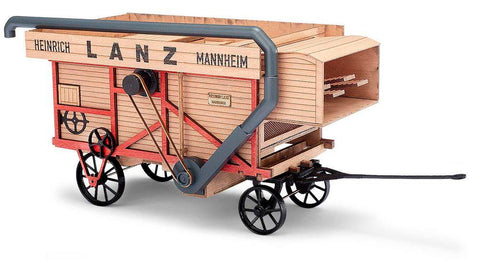
Busch 60120 G Threshing machine 1:32 Lanz
Early on people tried to cope with the tedious threshing of the grain in heavy manual labour - mechanical helpers had to come from! The history of the threshing machines begins already 1786 with a Schlagleistendrescher of the Scottish mechanical engineer Andrew Meikle. Since then, the machines have been further refined and improved. Initially powered by horses or steam engines - sometimes by hand - the threshers were powered by electric and stationary combustion engines or tractors. The threshing machines, also known as "threshing boxes", were initially made of wood before the revolutionary "steel lance" in all-steel construction was introduced in 1929. Gradually, this technical achievement was expanded and improved, until the 50s and 60s, the well-tried threshing machine was replaced by the fully automatic combine harvester and replaced by the market. In addition to various pictures and historical plans, an original model also inspired the model. In an old barn in the Vogtland open air museum Landwüst (district of Markneukirchen) a Lanz threshing machine could be located. This made it possible to clarify open questions. Even if the good old piece is already "aged", it is still in relatively good condition, so that in particular the colour scheme and structure could be easily removed. (The illustration shows the Dreschwagen with lowered roof gallery, so it can more easily retract into the low barn.) In addition to various pictures and historical plans, an original model also inspired the model. In an old barn in the Vogtland open air museum Landwüst (district of Markneukirchen) a Lanz threshing machine could be located. This made it possible to clarify open questions. Even if the good old piece is already "aged", it is still in relatively good condition, so that in particular the colour scheme and structure could be easily removed. (The illustration shows the Dreschwagen with lowered roof gallery, so it can more easily retract into the low barn.) In addition to various pictures and historical plans, an original model also inspired the model. In an old barn in the Vogtland open air museum Landwüst (district of Markneukirchen) a Lanz threshing machine could be located. This made it possible to clarify open questions. Even if the good old piece is already "aged", it is still in relatively good condition, so that in particular the colour scheme and structure could be easily removed. (The illustration shows the Dreschwagen with lowered roof gallery, so it can more easily retract into the low barn.) Even if the good old piece is already "aged", it is still in relatively good condition, so that in particular the colour scheme and structure could be easily removed. (The illustration shows the Dreschwagen with lowered roof gallery, so it can more easily retract into the low barn.) Even if the good old piece is already "aged", it is still in relatively good condition, so that in particular the colour scheme and structure could be easily removed. (The illustration shows the Dreschwagen with lowered roof gallery, so it can more easily retract into the low barn.) The miniature is modelled on the model from the year around 1911, a time in which one did not think of a fully automatic combine harvester. This, like its "big brother", made entirely of real wood, has a detailed design with lateral drive wheels with (rigid) drive belts. These in turn were set in motion by means of further drive belts of steam engines or locomobiles. Noteworthy is the special applied structure of each individual board and the various flaps with hinges. Like the original, a swivelling side arm is attached to the model, which separates the wheat from the chaff and blows it far away into a container. The spoke wheels are also thin and super filigree - barely distinguishable from the prototype. The very fine, red offset double-sided strut framework makes the appearance of the threshing case really perfect. To achieve this perfection in the model, however, also 103 individual parts are necessary. Some of them are so tiny that you can hardly imagine what a painstaking crafting art is behind it to make this perfect collectors item. An art and a very special skill that has made the Erzgebirge famous all over the world - made of wood "Made in Germany". In spite of this elaborate and long manual work phase, all miniatures go through the quality assurance process again, to ensure that with this true-to-life replica you hold a brand product of the highest quality and design - a collectors item of the master class.
60120
